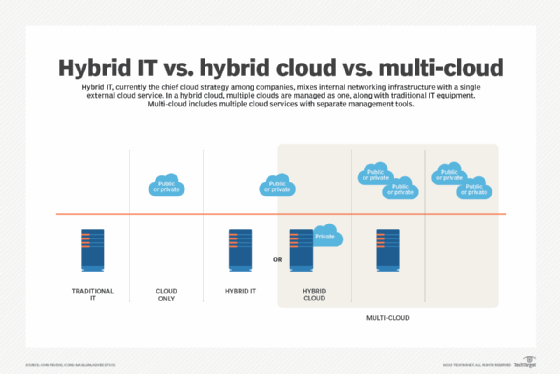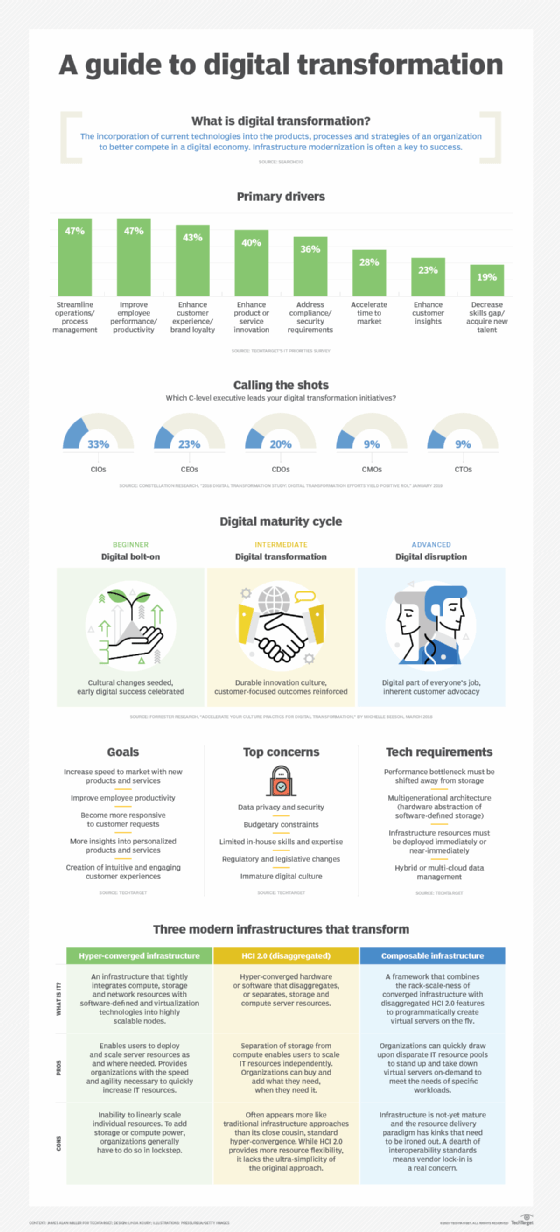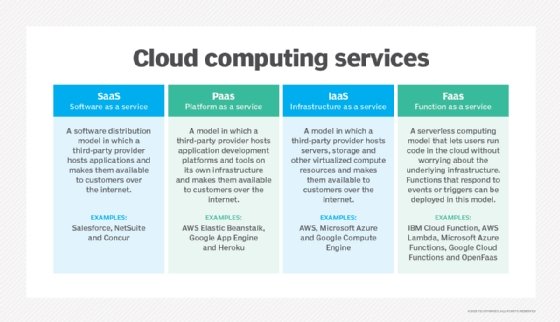hybrid IT
What is hybrid IT?
Hybrid IT is an approach to enterprise computing in which an organization provides and manages some information technology (IT) resources in-house but uses cloud-based services for others.
A hybrid approach allows an enterprise to maintain a centralized approach to IT governance while exploiting the benefits of cloud computing.
Hybrid IT vs. hybrid cloud
The term hybrid IT is often used interchangeably with the term hybrid cloud.
Hybrid cloud, however, can also refer to a cloud architecture in which a vendor who has a private cloud forms a partnership with a public cloud provider -- or a public cloud provider who forms a partnership with a vendor that provides private cloud platforms.
So while hybrid IT is a form of hybrid cloud, not all hybrid clouds are considered hybrid IT.

The benefits of hybrid IT
There are three forces driving the adoption of hybrid IT: an enterprise's need to maintain control of data for security purposes, the cost-effectiveness of cloud components such as software as a service (SaaS) and storage as a service, and the desire for an IT department to respond as quickly as possible to rapidly changing business needs.
Data security and hybrid IT
A hybrid IT environment blends the security and control of an on-premises environment with the flexibility and scalability of cloud services.
In this way, businesses can keep sensitive or regulated data in their on-premises IT infrastructure where certain standards can be met, while leveraging cloud resources to distribute apps, workloads and data that are not subject to cybersecurity regulations.
Cost efficiency and hybrid IT
While optimizing cost in a hybrid IT environment can take some finessing -- and often the help of a solutions partner that can customize pricing packages -- it can produce long-term cost savings. Furthermore, when managed well, modernization through a hybrid infrastructure can produce significant ROI.
For example, many hybrid cloud architectures allow users to pay for more storage or provisioning service nodes only as they need them, whereas most legacy systems require higher upfront costs and have set limits before expensive upgrades are needed.
This is helpful for both boot-strapped startup use cases and large-scale enterprises looking to make greater utilization of their IT budgets.
Flexibility and hybrid IT
Hybrid cloud environments also empower IT teams to optimize their resources while decreasing the amount of time spent on maintaining cloud infrastructure.
For example, service providers manage cloud maintenance and updates for you. This results in a significant amount of time saved for IT services and DevOps teams who typically manage these tasks.
For example, typically with on-premises infrastructure, upgrades and maintenance result in excessive downtime for users. With a hybrid IT model, cloud upgrades and maintenance are done for you requiring little to no downtime at all.
This frees IT professionals up to focus on optimizing infrastructure, providing end-user support and developing new features and applications. It also allows them to maintain legacy applications that are too deeply embedded for full cloud migration.
Furthermore, it provides the additional reliability and availability of an on-premises data center while still enjoying the benefits of a digital transformation that comes from cloud solutions.

What are some typical hybrid IT solutions?
Hybrid offerings typically come in three options: SaaS, IaaS and PaaS.
SaaS
SaaS offerings are provided by vendors that have cloud-based applications with wide-ranging functionality.
Usage is based on a subscription model, allowing organizations to scale up as needed. Examples include Microsoft Office 365 suite, Salesforce customer relationship management and Gmail.
IaaS
Infrastructure as a service (IaaS) offerings are structured as self-service, remote-hosted infrastructures which allow users to implement business process automation, store data, host applications and run IT processes.
IaaS vendors often deliver servers, networking, storage and a data layer remotely, accessible through a wide area network connection locally as virtual machines. They also typically incorporate monitoring functionality, audit logs, security protocols, node clustering, and backup and recovery features.
Pricing is somewhat different from SaaS providers and is based on a combination of user seats and server provisioning. This is often a good option for organizations with variable demands that require frequent optimization.
Examples include Amazon Web Services and Microsoft Azure.

PaaS
Platform as a service (PaaS) vendors are a combination of both SaaS and IaaS in that they provide both tools and infrastructure. PaaS offerings are typically sought after by organizations that want to develop and host their own applications and need to maximize efficiency in the software development lifecycle.
Payment terms can vary but are often set up in a pay-as-you-go model, though some veer more toward a subscription pay structure.
Examples include the Google App Engine and Atlassian.







